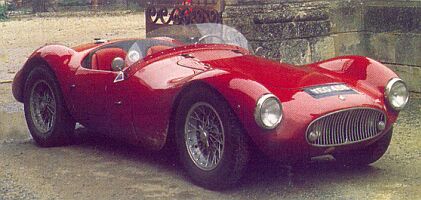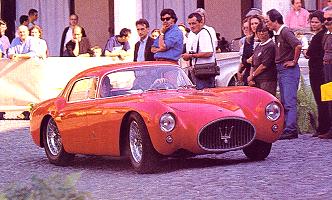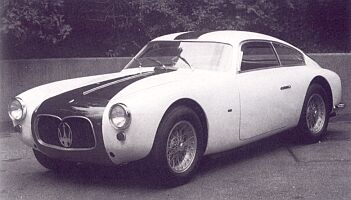These comprised a tubular steel frame, wishbone front
suspension and a live axle at the rear. The engine was an all-aluminium
in-line six cylinder unit of 1488cc capacity, with a single carburettor
(three were available as an option) and power output of 65bhp. A total
of 61 of these cars, in both coupe (mostly) and convertible style, were
produced until 1950.
Work soon started on a more powerful version of the
new car. Needing a larger engine, a new cast iron (Ghisa in Italian, hence
the G in the name) block was utilised and the car, introduced in 1951,
was named the A6G (sometimes referred to as the A6G2000). The resulting engine had a capacity of 1954cc and produced 100bhp, but
still had only one camshaft and only 16 were built (with bodies by Vignale, Frua, Pinin Farina and Zagato)
before the next development took over.
This was the A6G54, which arrived in 1954 (hence
the name). The chassis was effectively the same as the A6G, whilst the
engine was derived from the current Maserati formula two powerplant (changes included a chain drive for the camshafts rather
than the gears used in competition and the replacement of the dry sump lubrification with a conventional sump based system). It
was still an in-line six, but now displacing 1986cc with two plugs per
cylinder and generating 150bhp. Despite reverting to an alloy block the
G was kept in the name. The chassis was constructed by Gilco (apart from the first development one which was built in house) in order to
reduce the workload of the factory. Both the suspension and brakes were heavily influenced by the racing car.
A variety of coachbuilders produced bodies for the around 60 cars produced up until 1957, including Frua, Zagato and Allemano. The latter produced 21
coupés (the design was by Michelotti), known in-house as the Tipo C (the A and B were the Frua spider and coupé, the D the Zagato coupé).
Many were known as the A6GCS, the CS standing for 'Corsa Sport'. The
first Maserati designed specifically for the road, the A6 began to take
shape in 1941 during the war. In 1946 the first prototype was driven, in
1947 the official car debuted at the Turin Motorshow and it entered serious
production a year later. With the body designed and built by Pinin Farina,
Maserati concentrated on the engine, chassis and mechanicals.
The
first Maserati designed specifically for the road, the A6 began to take
shape in 1941 during the war. In 1946 the first prototype was driven, in
1947 the official car debuted at the Turin Motorshow and it entered serious
production a year later. With the body designed and built by Pinin Farina,
Maserati concentrated on the engine, chassis and mechanicals.
 |
 |
Technical Details
| Engine | A6 : 1488cc (66x72.5mm) sohc inline 6 with 65bhp @ 4,700rpm
A6G : 1954cc (72x80mm) sohc inline 6 with 100bhp @ 5,500rpm A6G54 : 1986cc (76.5x72mm) dohc twin plug inline 6 with 150bhp @ 6,000rpm |
| Suspension | front : wishbones and coil springs plus anti-roll bar
rear : live axle with coil springs (except A6G54 with leaf springs) plus anti-roll bar wheelbase : 2550mm track (front/rear) : 1274mm/1252mm (A6 & A6G) track (front/rear) : 1360mm/1220mm (A6G54) |
| Brakes | drums front and rear |
| Transmission | 4 speed manual |
| Steering | Worm and sector |
| Kerb weight | A6 : 950kg
A6G : 1100kg A6GCS : 740kg A6G54 : 840kg |
![]() See our Museo Bonfanti
and Monza weekend pages for pictures of some more A6 cars.
See our Museo Bonfanti
and Monza weekend pages for pictures of some more A6 cars.
There is also a list of all our picture galleries (including museums, motorshows and various events).
Copyright © 2000 to 2008 CarsfromItaly Use
the buttons at the top to navigate further, or
Use
the buttons at the top to navigate further, or